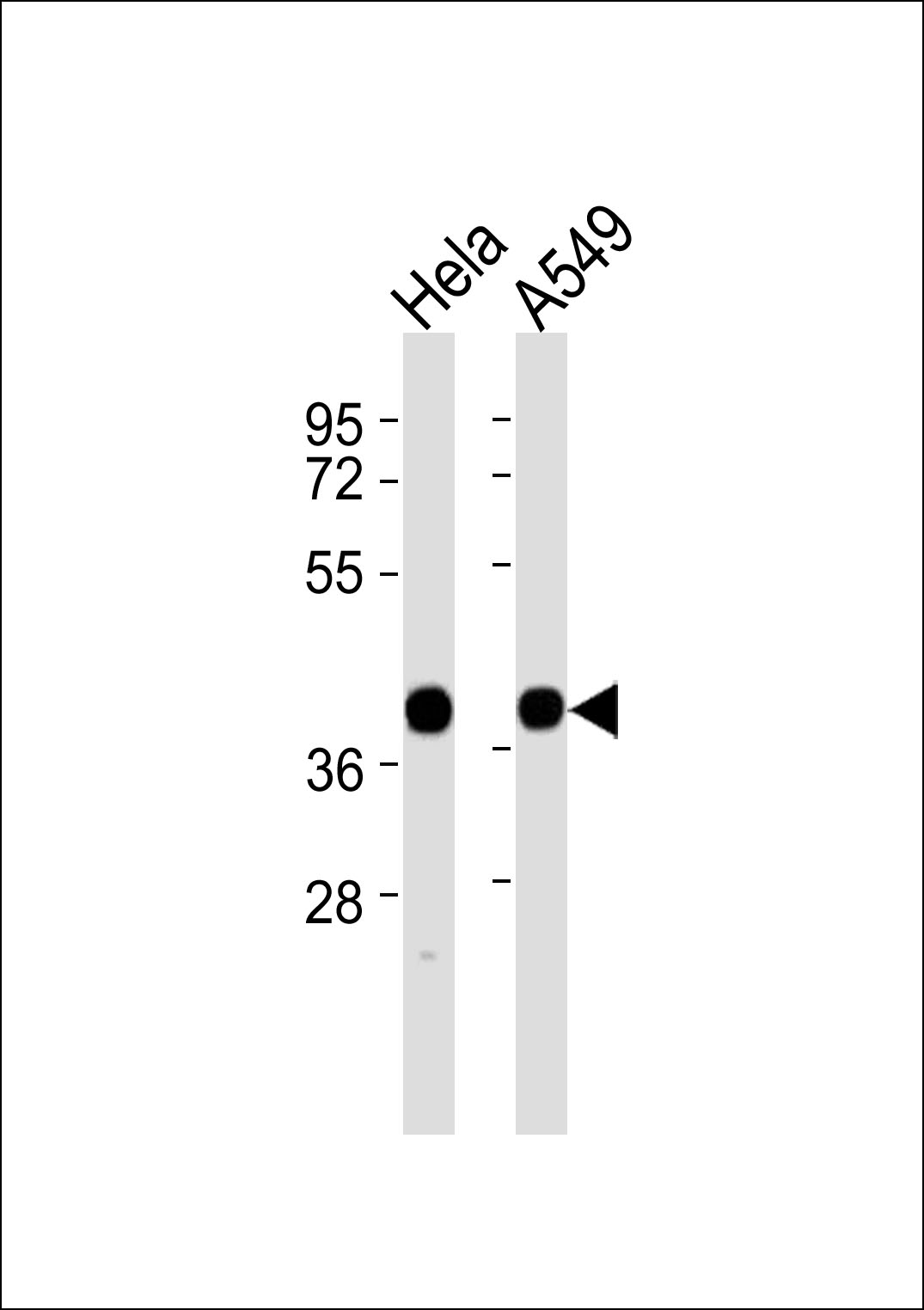ALDOA Antibody
Purified Rabbit Polyclonal Antibody (Pab)
- SPECIFICATION
- CITATIONS
- PROTOCOLS
- BACKGROUND

Application
| WB |
|---|---|
| Primary Accession | P04075 |
| Reactivity | Human, Mouse, Rat |
| Host | Rabbit |
| Clonality | Polyclonal |
| Calculated MW | 39 KDa |
| Antigen Region | 11 - 70 aa |
| Gene ID | 226 |
|---|---|
| Other Names | Fructose-bisphosphate aldolase A, Lung cancer antigen NY-LU-1, Muscle-type aldolase, ALDOA, ALDA |
| Target/Specificity | KLH-conjugated synthetic peptide encompassing a sequence within the N-term region of human ALDOA. The exact sequence is proprietary. |
| Dilution | WB~~ 1:1000 |
| Format | 0.01M PBS, pH 7.2, 0.09% (W/V) Sodium azide, Glycerol 50% |
| Storage | Store at -20 °C.Stable for 12 months from date of receipt |
| Name | ALDOA (HGNC:414) |
|---|---|
| Synonyms | ALDA |
| Function | Catalyzes the reversible conversion of beta-D-fructose 1,6- bisphosphate (FBP) into two triose phosphate and plays a key role in glycolysis and gluconeogenesis (PubMed:14766013). In addition, may also function as scaffolding protein (By similarity). |
| Cellular Location | Cytoplasm, myofibril, sarcomere, I band {ECO:0000250|UniProtKB:P00883}. Cytoplasm, myofibril, sarcomere, M line {ECO:0000250|UniProtKB:P00883}. Note=In skeletal muscle, accumulates around the M line and within the I band, colocalizing with FBP2 on both sides of the Z line in the absence of Ca(2+) {ECO:0000250|UniProtKB:P00883} |

Thousands of laboratories across the world have published research that depended on the performance of antibodies from Abcepta to advance their research. Check out links to articles that cite our products in major peer-reviewed journals, organized by research category.
info@abcepta.com, and receive a free "I Love Antibodies" mug.
Provided below are standard protocols that you may find useful for product applications.
Background
Plays a key role in glycolysis and gluconeogenesis. In addition, may also function as scaffolding protein (By similarity).
References
Sakakibara M.,et al.Biochem. Biophys. Res. Commun. 131:413-420(1985).
Izzo P.,et al.Eur. J. Biochem. 164:9-13(1987).
Izzo P.,et al.Eur. J. Biochem. 174:569-578(1988).
Mukai T.,et al.Eur. J. Biochem. 195:781-787(1991).
Ota T.,et al.Nat. Genet. 36:40-45(2004).
If you have used an Abcepta product and would like to share how it has performed, please click on the "Submit Review" button and provide the requested information. Our staff will examine and post your review and contact you if needed.
If you have any additional inquiries please email technical services at tech@abcepta.com.













 Foundational characteristics of cancer include proliferation, angiogenesis, migration, evasion of apoptosis, and cellular immortality. Find key markers for these cellular processes and antibodies to detect them.
Foundational characteristics of cancer include proliferation, angiogenesis, migration, evasion of apoptosis, and cellular immortality. Find key markers for these cellular processes and antibodies to detect them. The SUMOplot™ Analysis Program predicts and scores sumoylation sites in your protein. SUMOylation is a post-translational modification involved in various cellular processes, such as nuclear-cytosolic transport, transcriptional regulation, apoptosis, protein stability, response to stress, and progression through the cell cycle.
The SUMOplot™ Analysis Program predicts and scores sumoylation sites in your protein. SUMOylation is a post-translational modification involved in various cellular processes, such as nuclear-cytosolic transport, transcriptional regulation, apoptosis, protein stability, response to stress, and progression through the cell cycle. The Autophagy Receptor Motif Plotter predicts and scores autophagy receptor binding sites in your protein. Identifying proteins connected to this pathway is critical to understanding the role of autophagy in physiological as well as pathological processes such as development, differentiation, neurodegenerative diseases, stress, infection, and cancer.
The Autophagy Receptor Motif Plotter predicts and scores autophagy receptor binding sites in your protein. Identifying proteins connected to this pathway is critical to understanding the role of autophagy in physiological as well as pathological processes such as development, differentiation, neurodegenerative diseases, stress, infection, and cancer.


